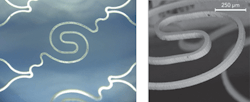Implantable medical devices such as stents, intraocular lenses (IOLs), and prosthetics have transformed medical treatment over past decades. For example, millions of stents are implanted worldwide each year to treat various vascular and endovascular diseases caused by the narrowing or blockage of blood vessels. Similarly, many millions of IOLs are implanted yearly as artificial lenses to restore vision for patients suffering from cataracts.
Lasers play a critical role in the fabrication of implantable medical devices. With their accurate control, lasers can be used to effectively micromachine a variety of selected materials to intricate and precise geometries needed for these implantable medical devices. In the case of coronary stents, laser cutting was employed with success almost from the very beginning. Early-generation stents were made from stainless steel and were relatively large with part geometry and feature tolerances of ±25 µm or more.1 Laser cutting, implemented with nanosecond-duration pulsed infrared lasers, easily met the accuracy requirements for machining at this level.
The thermal interaction of nanosecond laser pulses with the material, however, generally result in non-optimal surface finish on metal parts: burring, melting, and re-cast are common. In addition, heat deposition in the material results in a narrow heat affected zone (HAZ) bordering the cut edges. Within the HAZ, material properties or composition are altered. These effects have meant that laser cutting technology could only be scaled to volume stent production with the development and refinement of several costly and time consuming post-processing steps to remove rough edges. Cleaning, deburring, etching, and final polishing are routinely employed to bring the stent's surface properties to the level and consistency required of implantable devices.
Improvements with femtosecond lasers
In recent years, implantable medical devices have become increasingly intricate and utilize materials that are more difficult to machine. For example, stents are now being used for peripheral arteries with tiny dimensions. Another trend is to add a controlled surface texture or geometry to stents and prosthetics to improve bio-compatibility, for example to reduce the risk of restenosis. New materials that are bio-absorbable add another dimension to the challenge of fabricating these devices.
Femtosecond lasers are an enabling technology for micromachining the ultrafine structures and new materials for this new generation of implantable medical devices. Femtosecond lasers have pulse durations 100,000 times shorter than that of conventional nanosecond (ns) lasers. With these ultrashort pulses, the laser energy enters the material and departs with the expanding plasma before it can be transferred within the material as heat. The result is often called "cold" or "athermal" laser ablation. Its salient characteristic is the remarkably clean micro-scale machined features it produces, generally free of burrs, melting, re-cast and HAZ.
Femtosecond lasers have been around for several decades. Until more recently, though, they were complex, expensive, and required frequent tuning to sustain the demands of the production floor. However, products such as Spectra-Physics' Spirit industrial femtosecond laser, a proven, highly reliable, and robust laser, is widely deployed in demanding medical and manufacturing applications around the world.
To demonstrate the capability of the Spirit industrial femtosecond laser, we micro-machined ultrafine Nitinol metal stents as shown in FIGURE 1. The tube diameter and wall thickness are only 4.25 mm and 45 µm, respectively, and the strut width is 35 µm. We observe tight machining tolerances, absence of HAZ, no heat-induced distortion of the delicate lattice structure, and very clean-cut edges.
Bio-absorbable stents
Most commercially available stents are made from metals that remain in the arteries permanently after implantation and have a potential risk of causing serious medical complications. One potential solution to avoid such complications is to use stents made out of bio-absorbable materials that dissolve in the human body after serving their purpose.2 However, machining of bio-absorbable material is a highly challenging task.
Some common materials for bio-absorbable stents are poly-L-lactic acid (PLLA) and poly-lactic co-glycolic acid (PLGA). These materials have low-melting-points and therefore cannot tolerate the heat effects of conventional nanosecond-laser machining. Athermal ablation carried out by femtosecond lasers fundamentally enables the bio-absorbable stent technology by providing a viable manufacturing solution. It should be noted that, in these highly sensitive materials, even femtosecond lasers can leave behind heat-induced damage. However, by careful tuning of the laser output parameters, athermal ablation can still be achieved. The same cannot be said of lasers with longer pulses. For example, with a picosecond laser, only thermal machining of these materials was observed, resulting in strong melting and bubbling of the PLLA material. FIGURE 2 shows some recent results achieved with the Spirit industrial femtosecond laser. The material is 80 µm thick PLLA, and the struts are 100 µm wide.Conclusions
Femtosecond lasers have enabled the fabrication of next-generation implantable medical devices. As these devices continue to increase in complexity with shrinking feature sizes and tolerances, novel geometries and surface texturing, and new bio-absorbable materials, the use of femtosecond lasers becomes increasingly necessary. Industrial-grade, reliable, and robust femtosecond lasers are critical to enabling the manufacturing of these complex medical devices with higher quality, minimal additional post-processing steps, and higher throughputs.
Acknowledgments
The authors would like to thank Lacey Haftoglou (Zeus Industrial Products, Inc.) for providing the PLLA samples.
Spirit industrial femtosecond lasers
Spectra-Physics' Spirit femtosecond lasers are widely deployed in demanding micromachining and medical applications. These rugged and versatile lasers deliver short 400 fs pulses with adjustable repetition rates from single-shot to >1 MHz and high energies of >40 µJ/pulse for optimal machining results.
References
1. B. Michaels, "Advanced machining processes are key to manufacturing tomorrow's stents," MPMN 27(7), 2011.
2. Y. Wang, D. Castro, T. Limon, and R. Rapoza, "Bioabsorbable stent development: the past, present, and future," in Proc. International Medical Devices Conf. & Exposition, 7:1-8, 2012.

